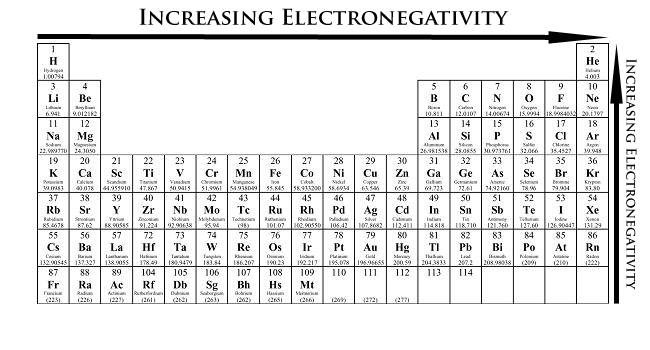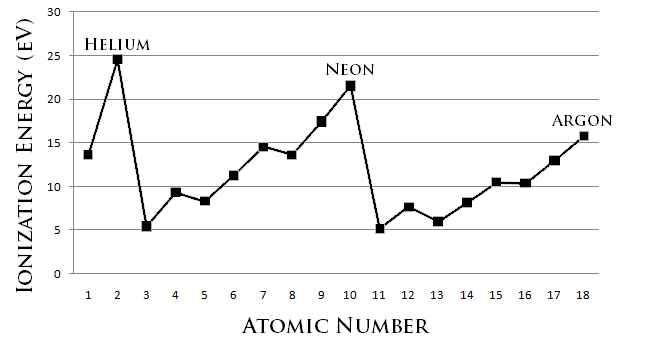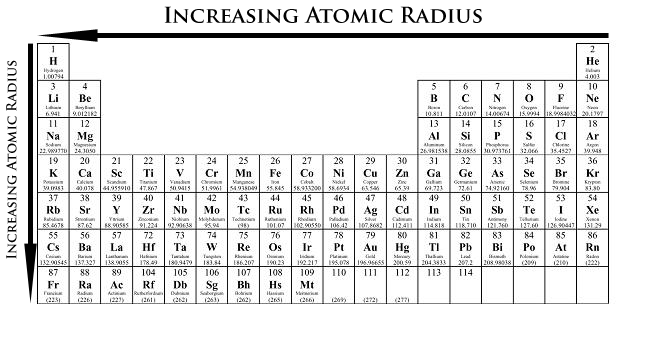How Does Atomic Size Change Within Groups And Across Periods
Periodic Trends
- Page ID
- 618
Periodic trends are specific patterns that are present in the periodic table that illustrate different aspects of a certain chemical element, including its size and its electronic properties. Major periodic trends include: electronegativity, ionization energy, electron affinity, atomic radius, melting point, and metallic graphic symbol. Periodic trends, arising from the organisation of the periodic table, provide chemists with an invaluable tool to apace predict an chemical element's properties. These trends be considering of the like diminutive structure of the elements within their respective group families or periods, and because of the periodic nature of the elements.
Electronegativity Trends
Electronegativity can be understood every bit a chemic property describing an cantlet'south ability to attract and demark with electrons. Because electronegativity is a qualitative property, there is no standardized method for computing electronegativity. However, the almost common scale for quantifying electronegativity is the Pauling scale (Table A2), named subsequently the chemist Linus Pauling. The numbers assigned past the Pauling calibration are dimensionless due to the qualitative nature of electronegativity. Electronegativity values for each chemical element tin be plant on certain periodic tables. An example is provided below.
Electronegativity measures an atom's tendency to attract and form bonds with electrons. This belongings exists due to the electronic configuration of atoms. Most atoms follow the octet rule (having the valence, or outer, vanquish comprise of 8 electrons). Because elements on the left side of the periodic table accept less than a half-total valence shell, the free energy required to gain electrons is significantly higher compared with the energy required to lose electrons. As a result, the elements on the left side of the periodic tabular array generally lose electrons when forming bonds. Conversely, elements on the right side of the periodic table are more energy-efficient in gaining electrons to create a consummate valence shell of eight electrons. The nature of electronegativity is effectively described thus: the more inclined an atom is to gain electrons, the more probable that atom will pull electrons toward itself.
- From left to right across a catamenia of elements, electronegativity increases. If the valence beat of an atom is less than half total, information technology requires less energy to lose an electron than to gain 1. Conversely, if the valence shell is more than half total, it is easier to pull an electron into the valence shell than to donate one.
- From top to lesser down a grouping, electronegativity decreases. This is considering atomic number increases downward a group, and thus there is an increased distance betwixt the valence electrons and nucleus, or a greater atomic radius.
- Important exceptions of the above rules include the noble gases, lanthanides, and actinides. The noble gases possess a complete valence vanquish and exercise non usually attract electrons. The lanthanides and actinides possess more complicated chemical science that does not generally follow whatever trends. Therefore, noble gases, lanthanides, and actinides do non have electronegativity values.
- Every bit for the transition metals, although they take electronegativity values, there is petty variance among them across the menstruation and up and downward a group. This is considering their metallic properties affect their power to attract electrons as hands every bit the other elements.
According to these two general trends, the virtually electronegative chemical element is fluorine , with iii.98 Pauling units.

Ionization Energy Trends
Ionization energy is the energy required to remove an electron from a neutral atom in its gaseous phase. Conceptually, ionization energy is the opposite of electronegativity. The lower this energy is, the more readily the atom becomes a cation. Therefore, the higher this energy is, the more than unlikely it is the atom becomes a cation. By and large, elements on the correct side of the periodic table have a college ionization energy because their valence beat out is nigh filled. Elements on the left side of the periodic table have low ionization energies because of their willingness to lose electrons and become cations. Thus, ionization free energy increases from left to right on the periodic tabular array.

Another factor that affects ionization energy is electron shielding. Electron shielding describes the ability of an cantlet'southward inner electrons to shield its positively-charged nucleus from its valence electrons. When moving to the right of a period, the number of electrons increases and the strength of shielding increases. As a result, it is easier for valence beat electrons to ionize, and thus the ionization energy decreases downward a group. Electron shielding is too known as screening.
Trends
- The ionization energy of the elements within a catamenia generally increases from left to right. This is due to valence beat stability.
- The ionization energy of the elements inside a group mostly decreases from top to bottom. This is due to electron shielding.
- The noble gases possess very high ionization energies because of their full valence shells every bit indicated in the graph. Note that helium has the highest ionization energy of all the elements.
Some elements have several ionization energies; these varying energies are referred to as the beginning ionization energy, the 2d ionization energy, 3rd ionization energy, etc. The first ionization energy is the energy requiredto remove the outermost, or highest, energy electron, the second ionization energy is the energy required to remove any subsequent high-energy electron from a gaseous cation, etc. Below are the chemic equations describing the first and second ionization energies:
Kickoff Ionization Free energy:
\[ X_{(g)} \rightarrow X^+_{(1000)} + due east^- \]
Second Ionization Energy:
\[ Ten^+_{(grand)} \rightarrow X^{2+}_{(g)} + eastward^- \]
Generally, any subsequent ionization energies (2d, 3rd, etc.) follow the same periodic trend equally the first ionization free energy.

Ionization energies decrease as atomic radii increase. This observation is affected past \(due north\) (the principal breakthrough number) and \(Z_{eff}\) (based on the atomic number and shows how many protons are seen in the atom) on the ionization energy (I). The human relationship is given by the post-obit equation:
\[ I = \dfrac{R_H Z^2_{eff}}{n^ii} \]
- Across a flow, \(Z_{eff}\) increases and n (main quantum number) remains the same, so the ionization energy increases.
- Down a grouping, \(due north\) increases and \(Z_{eff}\) increases slightly; the ionization free energy decreases.
Electron Affinity Trends
As the name suggests, electron analogousness is the ability of an cantlet to have an electron. Unlike electronegativity, electron affinity is a quantitative measurement of the energy change that occurs when an electron is added to a neutral gas atom. The more negative the electron affinity value, the college an atom'south affinity for electrons.

Electron affinity generally decreases downwardly a group of elements because each atom is larger than the atom to a higher place it (this is the atomic radius tendency, discussed below). This means that an added electron is further abroad from the cantlet's nucleus compared with its position in the smaller atom. With a larger distance between the negatively-charged electron and the positively-charged nucleus, the strength of attraction is relatively weaker. Therefore, electron affinity decreases. Moving from left to right across a period, atoms become smaller as the forces of attraction become stronger. This causes the electron to movement closer to the nucleus, thus increasing the electron affinity from left to right beyond a flow.
- Electron affinity increases from left to right within a period. This is caused by the decrease in atomic radius.
- Electron affinity decreases from top to bottom within a group. This is caused by the increase in atomic radius.
Atomic Radius Trends
The atomic radius is i-half the distance between the nuclei of 2 atoms (just like a radius is half the diameter of a circle). Nonetheless, this idea is complicated past the fact that non all atoms are commonly leap together in the same style. Some are spring past covalent bonds in molecules, some are attracted to each other in ionic crystals, and others are held in metallic crystals. Nevertheless, it is possible for a vast majority of elements to form covalent molecules in which two like atoms are held together by a single covalent bond. The covalent radii of these molecules are ofttimes referred to every bit atomic radii. This altitude is measured in picometers. Atomic radius patterns are observed throughout the periodic tabular array.
Atomic size gradually decreases from left to correct across a period of elements. This is because, within a period or family of elements, all electrons are added to the same vanquish. Yet, at the same time, protons are being added to the nucleus, making it more positively charged. The effect of increasing proton number is greater than that of the increasing electron number; therefore, there is a greater nuclear attraction. This means that the nucleus attracts the electrons more strongly, pulling the cantlet'south shell closer to the nucleus. The valence electrons are held closer towards the nucleus of the atom. As a result, the atomic radius decreases.

D own a group, diminutive radius increases. The valence electrons occupy higher levels due to the increasing quantum number (n). Every bit a upshot, the valence electrons are further away from the nucleus as 'due north' increases. Electron shielding prevents these outer electrons from being attracted to the nucleus; thus, they are loosely held, and the resulting atomic radius is large.
- Atomic radius decreases from left to right within a period. This is caused by the increase in the number of protons and electrons beyond a flow. One proton has a greater effect than one electron; thus, electrons are pulled towards the nucleus, resulting in a smaller radius.
- Atomic radius increases from top to bottom within a grouping. This is caused by electron shielding.
Melting Indicate Trends
The melting points is the amount of free energy required to break a bond(s) to change the solid stage of a substance to a liquid. Generally, the stronger the bail between the atoms of an chemical element, the more energy required to break that bail. Because temperature is direct proportional to energy, a loftier bond dissociation energy correlates to a high temperature. Melting points are varied and do not generally class a distinguishable trend beyond the periodic table. Notwithstanding, certain conclusions can be fatigued from Figure \(\PageIndex{vii}\).
- Metals by and large possess a high melting indicate.
- Virtually not-metals possess low melting points.
- The non-metal carbon possesses the highest melting point of all the elements. The semi-metal boron also possesses a loftier melting point.

Metal Character Trends
The metallic character of an element can be divers as how readily an atom tin lose an electron. From right to left across a flow, metallic character increases because the attraction between valence electron and the nucleus is weaker, enabling an easier loss of electrons. Metallic character increases every bit you motility downwards a grouping because the atomic size is increasing. When the atomic size increases, the outer shells are farther away. The principal breakthrough number increases and average electron density moves further from nucleus. The electrons of the valence shell have less attraction to the nucleus and, equally a effect, can lose electrons more readily. This causes an increase in metallic character.
- Metallic characteristics decrease from left to correct across a menstruum. This is caused by the decrease in radius (caused past Zeff, as stated in a higher place) of the atom that allows the outer electrons to ionize more readily.
- Metal characteristics increase down a group. Electron shielding causes the atomic radius to increment thus the outer electrons ionizes more readily than electrons in smaller atoms.
- Metallic grapheme relates to the ability to lose electrons, and nonmetallic grapheme relates to the power to gain electrons.
Another easier manner to retrieve the trend of metal character is that moving left and down toward the bottom-left corner of the periodic table, metallic character increases toward Groups 1 and 2, or the alkali and alkaline globe metallic groups. Likewise, moving up and to the right to the upper-right corner of the periodic table, metallic grapheme decreases because you are passing by to the right side of the staircase, which point the nonmetals. These include the Grouping eight, the noble gases, and other common gases such every bit oxygen and nitrogen.
- In other words:
- Move left beyond menses and down the group: increase metallic grapheme (heading towards brine and alkaline metals)
- Motility right beyond period and up the group: decrease metallic character (heading towards nonmetals like noble gases)

Problems
The post-obit serial of problems reviews full general understanding of the same cloth.
ane. Based on the periodic trends for ionization energy, which chemical element has the highest ionization free energy?
- Fluorine (F)
- Nitrogen (North)
- Helium (He)
2.) Nitrogen has a larger atomic radius than oxygen.
- A.) True
- B.) False
3.) Which has more metallic grapheme, Lead (Pb) or Tin (Sn)?
4.) Which element has a higher melting point: chlorine (Cl) or bromine (Br)?
5.) Which element is more electronegative, sulfur (S) or selenium (Se)?
6) Why is the electronegativity value of most noble gases zip?
7) Arrange these atoms in order of decreasing constructive nuclear charge past the valence electrons: Si, Al, Mg, S
8) Rewrite the following list in order of decreasing electron analogousness: fluorine (F), phosphorous (P), sulfur (S), boron (B).
9) An cantlet with an atomic radius smaller than that of sulfur (South) is __________.
- A.) Oxygen (O)
- B.) Chlorine (Cl)
- C.) Calcium (Ca)
- D.) Lithium (Li)
- E.) None of the to a higher place
10) A nonmetal has a smaller ionic radius compared with a metal of the same period.
- A.) Truthful B.) Fake
Solutions
1. Answer: C.) Helium (He)
Explanation: Helium (He) has the highest ionization energy because, like other noble gases, helium's valence shell is full. Therefore, helium is stable and does not readily lose or proceeds electrons.
2. Answer: A.) Truthful
Explanation: Diminutive radius increases from right to left on the periodic tabular array. Therefore, nitrogen is larger than oxygen.
3. Answer: Pb (Atomic number 82)
Caption: Lead and tin share the same column. Metallic character increases down a cavalcade. Atomic number 82 is under can, so atomic number 82 has more metal grapheme.
iv. Answer: Bromine (Br)
Caption: In non-metals, melting point increases down a column. Because chlorine and bromine share the same column, bromine possesses the higher melting point.
5. Reply: Sulfur (S)
Explanation: Notation that sulfur and selenium share the same column. Electronegativity increases upwardly a column. This indicates that sulfur is more electronegative than selenium.
half-dozen. Respond: Most noble gases have full valence shells.
Explanation: Because of their full valence electron beat, the noble gases are extremely stable and exercise non readily lose or gain electrons.
7. Reply: South > Si > Al > Mg.
Caption: The electrons above a closed beat are shielded by the airtight beat out. S has 6 electrons in a higher place a closed crush, and so each one feels the pull of 6 protons in the nucleus.
8. Reply: Fluorine (F)>Sulfur (Southward)>Phosphorous (P)>Boron (B)
Explanation: Electron affinity more often than not increases from left to right and from bottom to top.
9. Answer: C.) Oxygen (O)
Explanation: Periodic trends bespeak that atomic radius increases up a group and from left to correct across a period. Therefore, oxygen has a smaller atomic radius sulfur.
10. Answer: B.) Fake
Explanation: The reasoning behind this lies in the fact that a metallic usually loses an electron in becoming an ion while a non-metal gains an electron. This results in a smaller ionic radius for the metallic ion and a larger ionic radius for the not-metal ion.
References
- Pinto, Gabriel. "Using Balls of Different Sports To Model the Variation of Atomic Sizes." J. Chem. Educ. 1998 75 725.{cke_protected}{C}
- Qureshi, Pushkin M.; Kamoonpuri, S. Iqbal Grand. "Ion solvation: The ionic radii problem." J. Chem. Educ. 1991, 68, 109.
- Smith, Derek West. "Atomization enthalpies of metallic elemental substances using the semi-quantitative theory of ionic solids: A unproblematic model for rationalizing periodic trends." J. Chem. Educ. 1993, 70, 368.
- Russo, Steve, and Mike Silver. Introductory Chemistry. San Francisco: Pearson, 2007.
- Petrucci, Ralph H, et al. General Chemistry: Principles and Modern Applications. ninth Ed. New Jersey: Pearson, 2007.
- Atkins, Peter et. al, Physical Chemistry, 7th Edition, 2002, Due west.H Freeman and Company, New York, pg. 390.
- Alberty, Robert A. et. al, Concrete Chemical science, threerd Edition, 2001, John Wiley & Sons, Inc, pg. 380.
- Kots, John C. et. al, Chemistry & Chemical Reactivity, 5thursday Edition, 2003, Thomson Learning Inc, pg. 305-309.
Contributors and Attributions
- Swetha Ramireddy (UCD), Bingyao Zheng (UCD), Emily Nguyen (UCD)
How Does Atomic Size Change Within Groups And Across Periods,
Source: https://chem.libretexts.org/Bookshelves/Inorganic_Chemistry/Supplemental_Modules_and_Websites_(Inorganic_Chemistry)/Descriptive_Chemistry/Periodic_Trends_of_Elemental_Properties/Periodic_Trends
Posted by: johnsonlossion.blogspot.com


0 Response to "How Does Atomic Size Change Within Groups And Across Periods"
Post a Comment